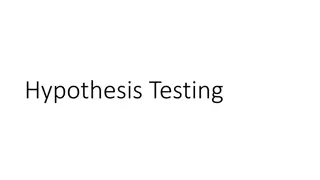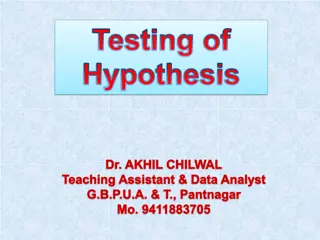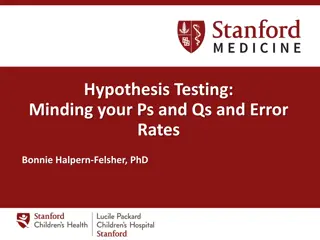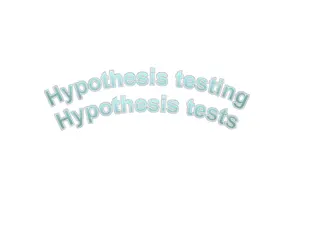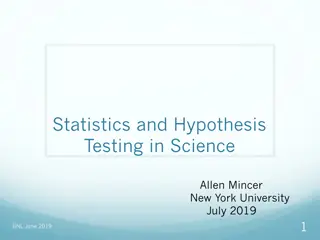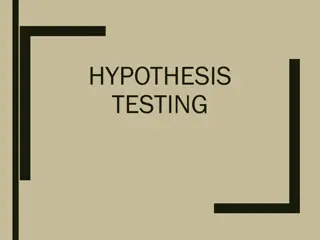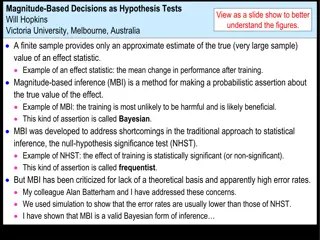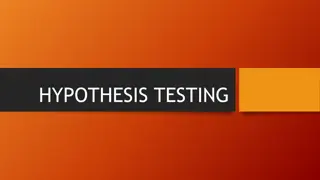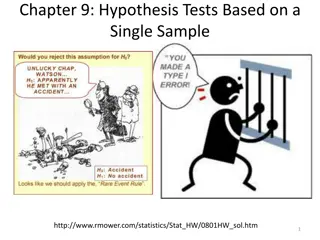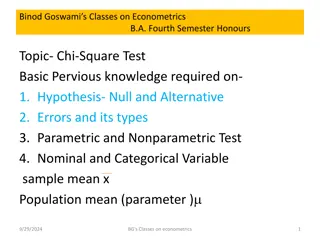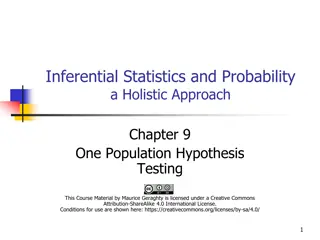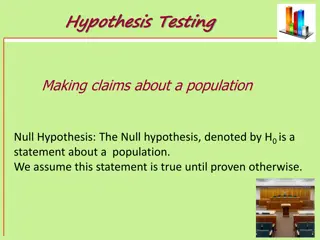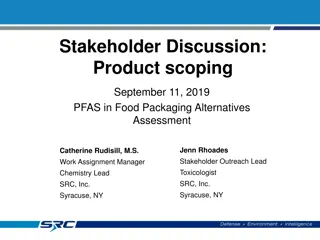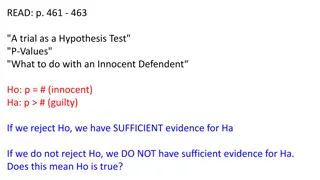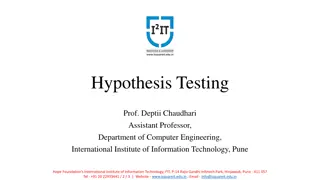Bayesian Estimation and Hypothesis Testing in Statistics for Engineers
In this course on Bayesian Estimation and Hypothesis Testing for Engineers, various concepts such as point estimation, conditional expectation, Maximum a posteriori estimator, hypothesis testing, and error analysis are covered. Topics include turning conditional PDF/PMF estimates into one number, es
3 views • 16 slides
Hypothesis Testing and Null vs. Alternative Hypotheses
A hypothesis is a prediction about a study's outcome, guiding research direction. Stating hypotheses forces deep thinking and making specific predictions but may introduce bias. Null hypothesis (H0) states no effect, while alternative hypothesis (Ha) claims an effect in the population. Researchers e
0 views • 7 slides
Hypothesis Testing in Statistical Analysis
Statistical analysis aims to make inferences about populations based on sample data. Hypothesis testing is a crucial aspect where decisions are made regarding accepting or rejecting specific values or parameters. Statistical and parametric hypotheses, null hypotheses, and decision problems are key c
5 views • 34 slides
Hypothesis Testing in Statistics
Hypothesis testing is essential in scientific inquiry, involving the formulation of null and alternative hypotheses at a chosen level of significance. Statistical hypotheses focus on population characteristics and are tested on samples using probability concepts. The null hypothesis assumes no effec
7 views • 26 slides
Uganda's Successes in Reaching Men with HIV Testing Through Assisted Partner Notification Program
Uganda has successfully implemented an Assisted Partner Notification (APN) program to reach men for HIV testing, addressing the gender gap in testing rates. By utilizing various approaches such as index testing, self-testing, and social network testing, Uganda has achieved significant success in tar
7 views • 12 slides
Hypothesis Testing: Examples and Interpretation
This content covers various examples of hypothesis testing scenarios, including car drivers' preferences for turning directions, the effectiveness of a new drug compared to a standard treatment, and the probability of seeds germinating in a greenhouse. It explains how to formulate null and alternati
2 views • 11 slides
Software Testing Foundation Level: Testing Throughout the SDLC Quiz
Explore key concepts in software testing throughout the Software Development Lifecycle (SDLC) with a quiz covering topics like white-box testing in acceptance testing, component testing vs. system testing, and regression testing purposes. Enhance your understanding of testing methodologies with samp
12 views • 17 slides
Hypothesis Testing and Statistics in Science
This collection of images and quotes explores the concepts of hypothesis testing, statistics, and the relationship between theory and measurement in science. It delves into the famous quote by Mark Twain about the deceptive nature of figures and provides examples of hypothesis testing problems in re
3 views • 41 slides
Hypothesis Testing in Statistics
Explore the concept of hypothesis testing through an engaging scenario involving Edison light bulbs. Learn about factors influencing hypothesis testing such as variability, sample size, and sample mean. Discover the logic behind hypothesis testing using Jake's napkin dispensers example. Enhance your
0 views • 28 slides
Magnitude-Based Decisions in Hypothesis Testing
Magnitude-based decisions (MBD) offer a probabilistic way to assess the true effects of experiments, addressing limitations of traditional null-hypothesis significance testing (NHST). By incorporating Bayesian principles and acknowledging uncertainties, MBD provides a robust framework for drawing co
6 views • 22 slides
Hypothesis Testing in Statistics
Hypothesis testing is a fundamental concept in statistics that involves testing statements about population parameters. This content covers the basics of hypothesis testing, including types of hypotheses, examples, and the procedure involved in statistical hypothesis testing. It also explores the im
1 views • 23 slides
Hypothesis Testing in Statistics
This content discusses the fundamentals of hypothesis testing based on a single sample in statistics. It covers the assumptions for inference, the parts of a hypothesis test, statistical hypotheses, and provides examples of hypothesis tests and significance tests in practical scenarios. The importan
1 views • 69 slides
Testing in Software Engineering
In the previous session, we discussed various aspects of software engineering, including modeling with UML diagrams, such as activity diagrams, use case diagrams, sequence diagrams, state diagrams, and class diagrams, as well as architecture patterns. Testing was emphasized as a key aspect, highligh
5 views • 35 slides
Gray Box Testing in Software Development
Gray Box Testing is a software testing technique that involves testing the software with partial knowledge of its internal workings. It combines aspects of White Box Testing and Black Box Testing, allowing testers to check both the presentation layer and the code part of an application. Gray Box Tes
12 views • 14 slides
Hypothesis Testing and Types of Errors in Econometrics
Hypothesis testing is vital in econometrics to evaluate statements about population parameters. The null hypothesis assumes no difference, while the alternative hypothesis offers a different perspective. Different types of errors—such as Type I and Type II errors—can occur during hypothesis test
5 views • 11 slides
Unit Testing in Software Engineering
Concept Software is a discipline comprising various code pieces. Testing these codes together is complex but vital in Software Engineering. The process includes early testing like unit tests, pairwise/multiple component testing, module testing, integration testing, user tests, alpha tests, beta test
4 views • 6 slides
Hypothesis Testing in Statistics
This content explores the concept of hypothesis testing in statistics, covering the procedures, general research questions, examples, and hypothesis design. It explains the formulation of hypotheses, decision criteria, significance levels, and the importance of testing population parameters. Various
4 views • 97 slides
Plant Chemistry and Phytonutrients: Insights from Research
Exploring the diverse world of plant chemistry, this content delves into primary and secondary metabolites, highlighting the significance of phytonutrients in maximizing nutritional content. Various hypotheses such as the Insecticide Hypothesis and Co-evolution Hypothesis are discussed, shedding lig
0 views • 61 slides
Hypothesis Testing
Hypothesis testing involves making claims about a population, such as the null hypothesis assumption and testing against sample data. Learn about examples of testing drug effectiveness and student heights in Ireland.
0 views • 5 slides
Hypothesis Testing
Hypothesis testing is a key aspect of statistical analysis, involving the formulation of null and research hypotheses, understanding p-values, errors, significance, and more. Learn about different types of hypothesis testing, common statistical tests, steps in hypothesis testing, and how to interpre
2 views • 30 slides
Visualization Basics and Statistics Hypothesis Testing
This content covers topics on Visualization basics, statistics basics, exploring penguins dataset, scatter plots replication, merging plots, hypothesis testing, and more. It discusses concepts like null hypothesis, alternative hypothesis, p-values, significance levels, and standard deviation. Explor
1 views • 12 slides
Penguins Visualization and Statistical Hypothesis Testing
This content covers various topics related to penguins, including visualization basics, statistics basics, exploring penguins dataset, scatter plots, merging plots, and hypothesis testing. It delves into how different penguin species are represented in scatter plots and discusses the process of hypo
1 views • 9 slides
Hypothesis Testing and P-Values
The concepts of hypothesis testing, P-values, making errors, and the power of hypothesis testing in statistical analysis. Learn about Type I and Type II errors, significance vs. importance, and how to interpret P-values to draw meaningful conclusions from data.
3 views • 20 slides
Hypothesis Testing
Hypothesis testing is a crucial aspect of statistical analysis, where hypotheses are formulated, tested, and conclusions are drawn regarding parameters. This process involves setting null and alternate hypotheses, determining p-values and significance levels, and understanding Type I and Type II err
4 views • 11 slides
Hypothesis Testing in Statistics: Understanding Testing Procedures
Hypothesis testing is a fundamental method in statistics to validate assumptions about population parameters. This process involves formulating null and alternative hypotheses, selecting significance levels, identifying test statistics, and making decisions based on sample evidence. By following a s
2 views • 15 slides
Hypothesis Testing in Statistics
Hypothesis testing is a fundamental statistical method used to investigate and make decisions based on experimental data. It involves formulating null and alternative hypotheses, selecting a level of significance, identifying test statistics, and applying decision rules. By following a five-step pro
0 views • 5 slides
Hypothesis Testing: Key Concepts and Steps
Learn the key concepts of hypothesis testing, such as p-values, significance levels, and one-tailed vs. two-tailed tests. Understand the steps involved in conducting a hypothesis test and interpreting the results to determine statistical significance. Explore practical examples and improve your anal
1 views • 29 slides
Hypothesis testing
Explore hypothesis testing in statistics including the process of formulating null and alternative hypotheses, conducting tests, and interpreting results. See examples involving binomial distributions and multiple-choice testing. Understand the significance of critical regions and significance level
2 views • 15 slides
Overview of Statistical Inference and Hypothesis Testing
Discover the key concepts of statistical inference, including the central limit theorem, confidence intervals, margin of error, and hypothesis testing. Learn how to make conclusions about populations from sample data and how engagement can be assessed and analyzed. Dive into decision-making processe
2 views • 39 slides
Levels of Software Testing
Levels of software testing include Unit Testing, Integration Testing, System Testing, and Acceptance Testing, each serving a specific purpose in ensuring software quality and functionality. Unit testing focuses on individual components, while integration testing checks the interaction between module
2 views • 98 slides
Inference and Hypothesis Testing in Statistics
This content covers essential concepts in statistical inference, hypothesis testing, confidence intervals, and the scientific method. It explains the difference between null and alternative hypotheses and provides examples to illustrate their application in real-world scenarios. Through visual aids
0 views • 9 slides
Hypothesis Testing in Inferential Statistics
Dive into the world of hypothesis testing in inferential statistics, where descriptive statistics fall short. Learn the difference between a hypothesis and hypothesis testing, the steps involved, and the significance of p-values and confidence intervals in testing relationships and variations betwee
1 views • 36 slides
Inferential Statistics and Probability: One Population Hypothesis Testing
In this chapter, you will delve into the procedures of hypothesis testing, general research questions formulation, and hypothesis testing design. Examples and explanations about hypotheses, testing procedures, and statistical analysis are presented to enhance your understanding. The content covers c
3 views • 97 slides
Hypothesis Testing in Econometrics: Overview and Types
Explore the world of hypothesis testing in econometrics, focusing on null and alternative hypotheses, errors in testing, and different types of hypothesis statements. Gain insights into the significance of statistical techniques like Chi-Square, T-test, and F-test in validating hypotheses.
3 views • 8 slides
Hypothesis Testing in Statistics
Learn about hypothesis testing in statistics, including the definition of a hypothesis, the process of testing hypotheses, types of statistical hypotheses, null hypothesis, examples, and more. Dive into the world of data analysis with this comprehensive guide.
1 views • 34 slides
Hypothesis Testing and its Six Steps
Learn about hypothesis testing, a procedure to determine the likelihood of mutually exclusive statements. Explore parametric vs. non-parametric tests, directional vs. non-directional hypotheses, and the six steps involved in hypothesis testing, including assumptions about the population and sample.
2 views • 23 slides
Understanding Hypothesis Testing in Statistics
Explore the concept of hypothesis testing with real-world examples such as verifying household income data, assessing average tyre life, and analyzing share prices. Learn the steps involved in hypothesis testing using Z and T statistics for single populations to make informed decisions based on stat
0 views • 27 slides
Hypothesis Tests in Statistics: Introduction and Procedures
Explore the fundamentals of hypothesis testing in statistics, including two procedures - critical-value and p-value approaches. Understand the concepts of null and alternative hypotheses, types of errors, and significance levels. Dive into various types of hypothesis tests such as two-tailed, left-t
0 views • 25 slides
Understanding Hypothesis Testing in Econometrics
Explore the concepts of null and alternative hypotheses, errors in hypothesis testing, and different types of hypothesis testing techniques in the field of econometrics. Learn about the Chi-Square test, sample vs. population mean, parametric vs. nonparametric tests, and more.
0 views • 11 slides
Tech Inc. Student Coaching Slides: Analyzing Income Data & Hypothesis Testing
Enhance your data analysis skills with the Future Super Tech Inc. student coaching slides. Explore histograms, sample statistics, hypothesis testing steps, income variation, and more. Learn how to determine the proportion of citizens with disposable incomes over $1,000, calculate poverty levels, and
2 views • 12 slides

